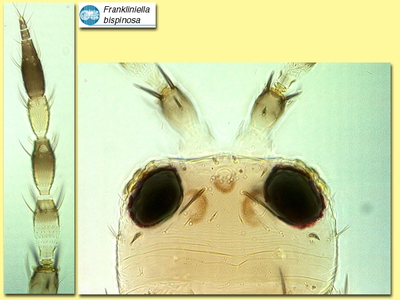Figures
Fig.1 Antenna and head
Fig. 2 Head and pronotum
Fig. 3 Fore and hind wing
Fig. 4 Tergite VII and VIII with ctenidium
Species
Frankliniella bispinosa MorganBiology
This polyphagous flower-living species damages citrus blossom and young avocado fruits in Florida.
Distribution
Common in Florida, Georgia and Alabama in USA.
Recognition
Body and legs yellow, tergites variably shaded medially, major setae dark; antennal segment I white, II dark at apex, III lightly shaded at apex, IV brown in distal half, V yellow, VI-VIII brown; forewings pale. Head as wide as long, with transverse lines of sculpture on vertex; 3 pairs of ocellar setae present, III on anterior margins of ocellar triangle; major pair of postocular setae shorter than ocellar setae III. Antennae 8-segmented, II with pair of stout dark setae on dorsal margin, III & IV with sense cone forked; pedicel of III with disc-shaped enlargement and distal to this a flask-shaped structure at base of segment. Pronotum with 2 pairs of long setae on anterior margin but median pair scarcely half as long as lateral pair, 2 pairs of long posteroangulars, and one pair of long posteromedial setae. Metanotum with median setae arising at anterior margin. Forewing with both longitudinal veins bearing complete row of setae. Tergites V-VIII each with a ctenidium laterally, on VIII anterolateral to spiracle; tergite VIII posterior margin with a comb of microtrichia laterally but not medially. Sternites with no discal setae. Male sternites III-VII with transverse glandular area.
Related species
Closely related to F. cephalica, a species with a similar third antennal segment that is widespread in the Caribbean islands and Central American region.





